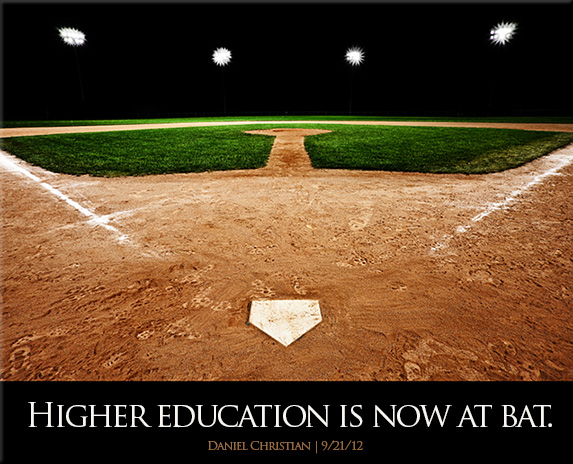The graphic below is from:
How strong is the business/IT relationship in your industry? — from Gartner.com by Mark P. McDonald; with thanks to Mr. Stephen Landry for putting this resource out on LinkedIn.
.

The graphic below is from:
How strong is the business/IT relationship in your industry? — from Gartner.com by Mark P. McDonald; with thanks to Mr. Stephen Landry for putting this resource out on LinkedIn.
.

The IT conversation we should be having — from HBR.org by Jim Stikeleather
Excerpt (emphasis DSC):
It is a conversation about the increasing importance of information technology and the role it must assume in every enterprise, regardless of size, industry or geography.
…
Our observations:
From DSC:
This is critical in the higher ed space as well!
The majority of the higher education industry still isn’t getting it — we are operating in a brand new ball game where technology must be used strategically. It’s not just about building and maintaining the infrastructure/plumbing anymore (though that is extremely important as well). It’s about the strategic, innovative use of IT that counts from here on out.
Review of higher ed adaptive learning products — from gettingsmart.com by Tom Vander Ark
Excerpt:
Last week we reviewed an EdGrowth white paper, A Case for Accelerating Adaptive Learning in HigherEd. Yesterday EdGrowth released a second paper that includes 8 profiles of adaptive learning providers.
Also see:
ADAPTIVE LEARNING IN HIGHER EDUCATION: A REALITY CHECK
Education Growth Advisors Report Makes Case for Accelerating Adaptive Learning in Higher Education
STAMFORD, CT (March 13, 2013) — Today, the higher education marketplace is thick with companies and organizations claiming to have “personalized learning” or “adaptive learning” capabilities. Companies are using this language in their sales and marketing efforts, creating confusion for institutions as they grapple with determining an approach to personalized learning that matches their students’ and instructors’ needs. But if one cuts through the clutter, adaptive learning may be one key capable of actually unshackling higher education from the “Iron Triangle” of cost, access and quality, according to a white paper by Education Growth Advisors. The white paper, entitled “Learning to Adapt: A Case for Accelerating Adaptive Learning in Higher Education”, funded by the Bill & Melinda Gates Foundation, explores the current adoption, opportunities, barriers, advancements, solutions and case studies of adaptive learning in higher education.
Also see:
Improving postsecondary education through the budget process: Challenges & opportunities — from The National Association of State Budget Officers (NASBO)
Excerpt:
The report, Improving Postsecondary Education Through the Budget Process: Challenges & Opportunities, discusses:
The professors who make the MOOCs — from The Chronicle by Steve Kolowich
Excerpt:
Like many professors at top-ranked institutions, Mr. Sedgewick was very skeptical about online education. But he was intrigued by the notion of bringing his small Princeton course on algorithms, which he had taught for five years, to a global audience. So after Princeton signed a deal with an upstart company called Coursera to offer MOOCs, he volunteered for the front lines.
Dave Chidley for The Chronicle
The Professors’ Big Stage — op-ed from the New York Times by Thomas Friedman
Excerpt:
I just spent the last two days at a great conference convened by M.I.T. and Harvard on “Online Learning and the Future of Residential Education” — a k a “How can colleges charge $50,000 a year if my kid can learn it all free from massive open online courses?”
The newest revolution in higher ed — from The Boston Globe by Drew Faust (president of Harvard Univeristy) and L. Rafael Reif (president of MIT)
Excerpt:
In 1837, the Massachusetts Board of Education devoted part of its first annual report to praising a recent classroom innovation called the blackboard. This “invaluable and indispensible” innovation enabled the “rapid and vivid communication of knowledge.” It created opportunities for teachers to engage learners in ways that had been unimaginable just a generation earlier.
The same and more will be said of online learning tools. We are at the beginning of a technology-led revolution in pedagogy: Our innovation is not the blackboard, but instead an evolving suite of tools that allows interactive learning online. While one outcome of this revolution has rightly caught the world’s attention — the power to democratize access to education on a scale never seen in history — we are just as excited about the promise that these new tools hold for colleges and universities throughout the world.
In Cisco’s classroom of the future, your professor is just an illusion — from fastcoexist.com by Ariel Schwartz
New telepresence software could let you take a class from anywhere and appear as if you’re in the classroom.
From DSC:
Below are some reflections after seeing these items:
.

From DSC:
The current set of MOOCs are very powerful, but, like a bush that needs pruning, they can become unwieldy and hard to control. Not only do the current set of MOOCs help me to see the importance of instructional design, but trying to drink from the firehose often presents problems (i.e. wading through thousands of tweets, hundreds of blog posts, etc.). How can we still provide openness and yet provide people with better methods/tools for setting their desired level of drinking from this firehose? Tags are helpful, but for most people, they are not doing enough to filter/curate the content at this point.
Enter the technologies being developed in IBM’s Watson, Apple’s SIRI, or in Knewton’s product lines. End-user controllable setting might include:
The ideas involving learning agents, artificial intelligence, intelligent tutoring, intelligent systems and more seem to get roped in here…hmm…just thinking out loud and sharing potentially-useful ideas.